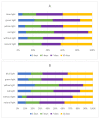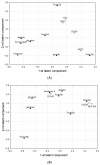Chickpea and Lupin Sprouts, Stimulated by Different LED Lights, As Novel Examples of Isoflavones-Rich Functional Food, and Their Impact on Breast and Prostate Cells
- PMID: 36558162
- PMCID: PMC9781113
- DOI: 10.3390/molecules27249030
Chickpea and Lupin Sprouts, Stimulated by Different LED Lights, As Novel Examples of Isoflavones-Rich Functional Food, and Their Impact on Breast and Prostate Cells
Abstract
Among all legumes sprouts' active compounds, isoflavones seem to be the most important; nevertheless, their high content is not always associated with beneficial effects. These compounds may prevent or stimulate hormone-dependent cancers due to their estrogen-like activity. Different LED light quality can change the synthesis of active compounds and significantly influence the biological activity of the sprouts. This study aimed to evaluate the effects of LED light (red, blue, green, yellow), as well as total darkness, and natural light conditions (as reference), on isoflavones content, determined by HPLC-UV-VIS, during 10 days of harvesting of chickpea and lupin sprouts. Due to the ambiguous estrogenic potential of isoflavones, the impact of these sprouts on normal and cancer prostate and breast cells was evaluated. Yellow LED light resulted in the highest sum of isoflavones in chickpea sprouts (up to 1 g/100 g dw), while for green LED light, the isoflavones sum was the lowest. The exact opposite effect was noted for lupin sprouts, with the predominance of green over the yellow LED light. The examined sprouts were of high safety to non-neoplastic breast and prostate cells, with interesting cytotoxic effects on breast MCF7 and prostate DU145 cancer cells. No clear relationship was observed between the activity and isoflavones content.
Keywords: LED light; breast cancer; isoflavones; legumes; prostate cancer; sprouts.
Conflict of interest statement
The authors declare no conflict of interest.
Figures







Similar articles
-
Chickpea Sprouts as a Potential Dietary Support in Different Prostate Disorders-A Preliminary In Vitro Study.Molecules. 2024 Feb 28;29(5):1044. doi: 10.3390/molecules29051044. Molecules. 2024. PMID: 38474555 Free PMC article.
-
In the Search for Novel, Isoflavone-Rich Functional Foods-Comparative Studies of Four Clover Species Sprouts and Their Chemopreventive Potential for Breast and Prostate Cancer.Pharmaceuticals (Basel). 2022 Jun 28;15(7):806. doi: 10.3390/ph15070806. Pharmaceuticals (Basel). 2022. PMID: 35890104 Free PMC article.
-
The estrogenic activity of isoflavones extracted from chickpea Cicer arietinum L sprouts in vitro.Phytother Res. 2013 Aug;27(8):1237-42. doi: 10.1002/ptr.4858. Epub 2012 Oct 15. Phytother Res. 2013. PMID: 23065723
-
Occurrence of isoflavones in soybean sprouts and strategies to enhance their content: A review.J Food Sci. 2022 May;87(5):1961-1982. doi: 10.1111/1750-3841.16131. Epub 2022 Apr 11. J Food Sci. 2022. PMID: 35411587 Review.
-
Interactions of isoflavones and other plant derived estrogens with estrogen receptors for prevention and treatment of breast cancer-considerations concerning related efficacy and safety.J Steroid Biochem Mol Biol. 2014 Jan;139:237-44. doi: 10.1016/j.jsbmb.2012.12.010. Epub 2012 Dec 27. J Steroid Biochem Mol Biol. 2014. PMID: 23274118 Review.
Cited by
-
Can Simulated Microgravity and Darkness Conditions Influence the Phytochemical Content and Bioactivity of the Sprouts?-A Preliminary Study on Selected Fabaceae Species.Plants (Basel). 2024 May 30;13(11):1515. doi: 10.3390/plants13111515. Plants (Basel). 2024. PMID: 38891323 Free PMC article.
-
Chickpea Sprouts as a Potential Dietary Support in Different Prostate Disorders-A Preliminary In Vitro Study.Molecules. 2024 Feb 28;29(5):1044. doi: 10.3390/molecules29051044. Molecules. 2024. PMID: 38474555 Free PMC article.
-
Impact of Storage on Bioactive and Toxic Compounds in Jicama (Pachyrhizus erosus) Tubers: Effects on Thyroid Cancer and Inflammatory Responses.Plant Foods Hum Nutr. 2025 Jun 13;80(3):138. doi: 10.1007/s11130-025-01381-0. Plant Foods Hum Nutr. 2025. PMID: 40512265 Free PMC article.
-
Physicochemical and Volatile Compounds Analysis of Fruit Wines Fermented with Saccharomyces cerevisiae: FTIR and Microscopy Study with Focus on Anti-Inflammatory Potential.Int J Mol Sci. 2024 May 22;25(11):5627. doi: 10.3390/ijms25115627. Int J Mol Sci. 2024. PMID: 38891815 Free PMC article.
-
Effect of Different Colours of Light on Chosen Aspects of Metabolism of Radish Sprouts with Phosphoromic Approach.Molecules. 2024 Nov 22;29(23):5528. doi: 10.3390/molecules29235528. Molecules. 2024. PMID: 39683687 Free PMC article.
References
-
- Cid-Gallegos M.S., Sánchez-Chino X.M., Juárez Chairez M.F., Álvarez González I., Madrigal-Bujaidar E., Jiménez-Martínez C. Anticarcinogenic activity of phenolic compounds from sprouted legumes. Food Rev. Int. 2020:1–16. doi: 10.1080/87559129.2020.1840581. - DOI
-
- Galanty A., Niepsuj M., Grudzińska M., Zagrodzki P., Podolak I., Paśko P. In the search for novel, isoflavone-rich functional foods—comparative studies of four clover species sprouts and their chemopreventive potential for breast and prostate cancer. Pharmaceuticals. 2022;15:806. doi: 10.3390/ph15070806. - DOI - PMC - PubMed
-
- Paśko P., Tyszka-Czochara M., Galanty A., Gdula-Argasińska J., Żmudzki P., Bartoń H., Zagrodzki P., Gorinstein S. Comparative study of predominant phytochemical compounds and proapoptotic potential of broccoli sprouts and florets. Plant Foods Hum. Nutr. 2018;73:95–100. doi: 10.1007/s11130-018-0665-2. - DOI - PMC - PubMed
-
- Ganesan K., Xu B. A critical review on phytochemical profile and health promoting effects of mung bean (Vigna radiata) Food Sci. Hum. Wellness. 2018;7:11–33. doi: 10.1016/j.fshw.2017.11.002. - DOI
MeSH terms
Substances
Grants and funding
- 1.012.996.2020/POB qLIFE, grant "Search for new candidates for phytoestrogen-rich functional foods, based on a cellular model of hormone-dependent cancers and chemometric analysis of safety and efficacy
- 06/IDUB/2019/94/The study was created with the use of equipment (Biotek Synergy microplate reader and Dionex HPLC system) co-financed by the qLIFE Priority Research Area under the program "Excellence Initiative-Research University" at Jagiellonian University.
LinkOut - more resources
Full Text Sources
Research Materials

